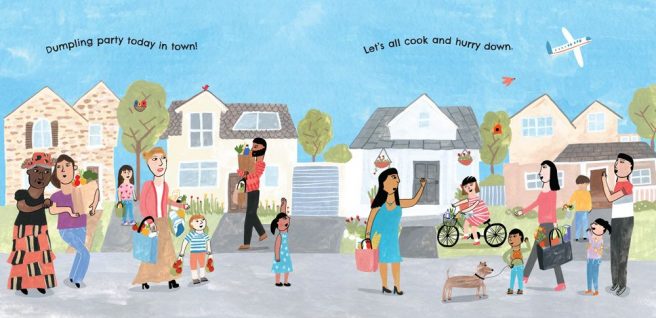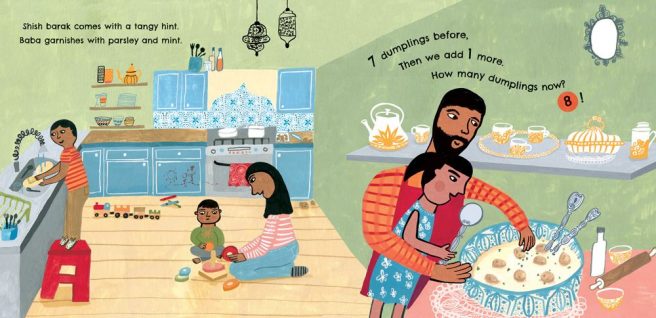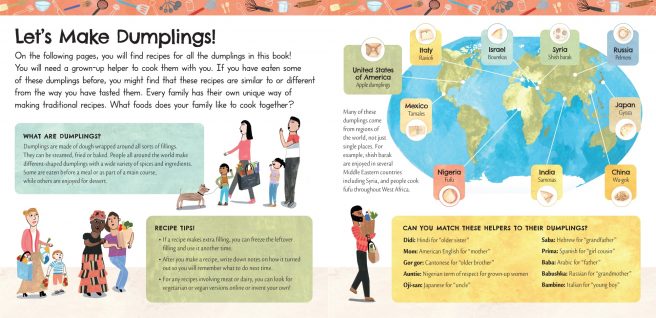
Dumplings? Did someone say dumplings?
Count me in!
In this mouthwatering story-counting book, ten ethnically diverse families make ten different kinds of dumplings for a neighborhood potluck. What could be more fun or delicious?

Dumpling party today in town! Let's all cook and hurry down.
Meera Sriram and Inés de Antuñano invite us to step into ten busy, bustling kitchens to see samosas, apple dumplings, wu-gok, fufu balls, gyoza, bourekas, tamales, shish barak, pelmeni, and ravioli being prepared by enthusiastic and hungry adults and children. Drooling yet?

Spicy samosas point to the sky. Didi is bringing chutney to try. 1 little dumpling on our plate now!
Sriram’s lively rhyming couplets provide tasty tidbits about each dumpling. What shape is it? Is it soft or crunchy? What’s in the filling and what kind of wrapper does it have? What about flavor — is it spicy or sweet? And how is the dumpling cooked — baked, steamed, fried, boiled — or as with fufu balls, eaten in a stew?
We also read about those who are helping with preparation or serving, though there are a couple of people whose primary interest is in eating, like Saba who “samples the puff pastry snack,” and Bambino, who begs, “Can I have one, please?”

As we move from kitchen to kitchen, we can just about hear the pop and sizzle of gyoza frying in the pan, smell the divine aroma of cinnamon-y apple dumplings in the oven, and even anticipate biting into the steamy goodness of beef-filled tamales. Ah!
And with each new dumpling, we keep counting what’s on the plate:
1 dumpling before, Then we add 1 more. How many dumplings now? 2! 2 dumplings before, Then we add 1 more. How many dumplings now? 3!
And so on. Hungrier and hungrier!
Once all the cooking’s done, everyone gathers in the park for a rousing picnic. The time has finally come to sample Gor gor’s fried taro dumplings, Prima’s tamales, and the pelmeni Babushka has topped with thick sour cream. Yum!

10 little dumplings and people to greet, 10 little dumplings ready to eat. We eat and laugh and gather round, We party till the sun goes down.
Bellies full, it’s finally time to count down — 10, 9, 8, 7, 6, 5, 4, 3, 2 . . . as the story ends with a lipsmacking surprise: there is one last dumpling on the plate especially for the reader!
Inés’s appealing gouache and digital kitchen interiors anchor Sriram’s text. Carefully placed details establish a cultural context: a folkloric rug and throw pillows for Nigeria, Asian wall hangings for Japan, floral ceramic tiles and succulent plants for Mexico, Islamic mosaic patterns for Syria. Crockery with traditional motifs are also a nice touch.

Ethnic identities aside, we see relatable family dynamics and activities showing how they, and ultimately we, are all alike: a busy mom talking into her phone while holding a baby, kids playing on the floor, girls helping their moms cook, pets wandering about.
The characters themselves, with their varying skin tones, facial features, and some of their clothing (older family members), amplify the universal appeal of dumplings. Each culture has its own special type of dumpling passed down through generations, and there is palpable communal joy in preparing, eating, and sharing.

After reading this toothsome tale, readers no doubt will want to eat their favorites and try any that are new to them. Lucky for us, educational consultant Laurel P. Jackson has created recipes (with color photos) for each of the dumplings mentioned in the book (to be made with adult supervision). I’m especially curious to try bourekas (since I love puff pastry) and shish barak (the tiny meat dumplings cooked in a yogurt stew sounds intriguing).
More backmatter includes recipe tips and a map showing where the ten dumplings originated: India, USA, China, Nigeria, Japan, Israel, Mexico, Syria, Russia, Italy. Also like that there’s a list of the helpers, with translations of their names (Saba, Prima, Baba, Oji-san) and readers are asked to match them to their dumplings.

Don’t miss this savory celebration of food, families, communities, culinary and cultural diversity. Will it make you hungry? You can count on it!
What is your favorite kind of dumpling? 🙂
*

DUMPLING DAY
written by Meera Sriram
illustrated by Inés de Antuñano
recipes by Laurel P. Jackson
published by Barefoot Books, October 2021
Picture Book/Counting Book for ages 4-9, 40 pp.
*Includes Let’s Make Dumplings Endnotes + 10 recipes
*

The lovely and talented Michelle Kogan is hosting the Roundup this week. Take her a dumpling or two, then check out the full menu of poetic goodness being served up around the blogosphere. Happy December!
*Interior spreads text copyright © 2021 Meera Sriram, illustrations © 2021 Inés de Antuñano, published by Barefoot Books. All rights reserved.
**This post contains Amazon and Bookshop Affiliate links. When you purchase an item using either link, Jama’s Alphabet Soup receives a small referral fee at no additional cost to you. Thank you for your support.
***Copyright © 2021 Jama Rattigan of Jama’s Alphabet Soup. All rights reserved.

‘Count me in’ on the awesomeness of Dumpling Day, Jama! Yum! Your review is ‘smartpling’. 😉
LikeLiked by 1 person
LOL. Always the punster — you fill me with laughter. 🙂
LikeLike
One of our favorite memories is going to a Chinese restaurant and ordering pot stickers for an appetizer and dumplings for the main course, and when they arrived, they were exactly the same! Did we care? No! Just more dumplings for us!!!
LikeLiked by 1 person
Wonder why they were listed differently on the menu if they were the same?
LikeLike
It is one of those enduring mysteries! LOL
LikeLike
Yum! I love the illustrations!
LikeLiked by 1 person
It’s a fun book that makes you hungry.
LikeLike
I got hungry reading this. I love dumplings! This sounds like a great book for someone like me and a great gift. Thanks Jama.
LikeLiked by 1 person
Just the word dumpling makes me happy. Comfort personified.
LikeLike
Another dumpling book is always a a good thing! Looks. yummy!
LikeLiked by 1 person
I thought of Dumplings for Lili while reading this. They do have a way of bringing people together.
LikeLike
I am all in for this book! I’m fascinated by foods that cross cultural lines (like flat breads), and YOU’RE the one who got me started with puff pastry, so I’m right behind you with trying out as many of these recipes as possible!!
LikeLiked by 1 person
Always more to learn when it comes to dumplings. I need a live-in chef to make all these recipes for me. 😀
LikeLike
Yum, I’m hungry now and would love one of the samosas please, though they all sound good and the Fufu and Peanut Stu sounds yummy too. Thanks Jama for sharing this lovely post and new book, with fun/colorful art too!
LikeLiked by 1 person
Have as many samosas as you like, Michelle!!
LikeLiked by 1 person
I agree, just the word dumpling is both fascinating and amusing, isn’t it? Thanks for this scrumptious review…
LikeLiked by 1 person
Thanks for reading, Karen!
LikeLike
Well, just in time for our “and one more makes ?” weeks in PreK! This post makes me less afraid of dumplings, but I fear that they require more patience than I can muster. Thanks for the very very very complete peek, Jama!
LikeLiked by 1 person
I think the easier recipes — where you don’t have to make both the filling and the wrappers — are more doable. In any case, the recipes are geared for older kids with help from parents.
LikeLike
I should know better than to come to your blog hungry. Now I want samosas! 🙂 This is an excellent share. Thank you. I look forward to checking it out.
LikeLiked by 1 person
Mmmm, samosas!
LikeLike
Thank you, Jama! I definitely need this book for my school library. I’m adding it to a wish list right now.
LikeLiked by 1 person
Yay!
LikeLike
Such a delicious treat! I’ve requested our library purchase this thanks to you!
LikeLiked by 1 person
Happy to hear that!!!
LikeLike